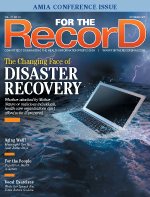October  2015
2015
How to Maximize an EHR Investment
By Heather Haugen, PhD
For The Record
Vol. 27 No. 10 P. 25
Organizations investing in new health technology face an important milestone when installing systems such as EHRs. EHRs can enhance patient safety and clinical research outcomes, which are important factors when considering the cost of these systems. According to the 2014 Health IT dashboard on HealthIT.gov, approximately 75% of all US hospitals are adopting EHRs, but many still struggle to use the systems effectively and efficiently. Making the EHR work positively for care providers ensures a successful return on investment.
Organizations face several challenges when adopting, implementing, and optimizing EHRs, including disengaged leadership, clinician resistance, and interoperability issues. A structured, research-based approach is recommended to achieve system optimization. Organizations that engage clinician leadership, offer targeted education and communication, establish metrics, and provide a sustainable focus on education will succeed in getting the most out of their EHR investment.
Engaged Clinician Leadership
IT leaders are often accountable for overseeing system installations because they are responsible for the build. While their technical skills are necessary for a successful HIT system installation, it's also critical to tap the expertise of clinician leaders, whose responsibilities include driving quality care outcomes within the organization. This requires clinician leaders to commit to establishing best practice workflows and parameters for colleagues to follow and evolve over time.
After an EHR goes live, competing priorities often make it difficult to maintain the initial degree of clinician leadership engagement. This can cause problems, namely because clinicians should stay involved with decisions regarding upgrades, workflow refinement, and education to ensure a high level of EHR adoption in the long term.
Delaying clinician leadership involvement can cause resistance and affect an organization's culture. The difference in the end result depends on how early clinical leaders are involved in the decision-making process. Clinicians need time and resources to fully engage in adopting and optimizing the system throughout the process.
Targeted Education and Communication
Let's face it, traditional instructor-led classroom training can be painful. It's often designed so poorly that it does little to help clinicians become proficient in using HIT systems.
Role-based education using the actual application not only is more effective but also saves time. Caregivers learn in the actual EHR application and master only those tasks that are applicable to their role. Role-based training customized by workflows can speed adoption and keep clinicians focused on their biggest priority: caring for patients. Through hands-on experience in a familiar environment, clinicians learn faster and retain more knowledge than in traditional instructor-led classroom training.
Role-based training can be completed in convenient five- to seven-minute increments or in structured computer lab sessions. Both provide a quick way to learn the improved workflows, system upgrades, and advanced functionality of the EHR.
In addition to targeted education, the communication plan must reinforce the importance of the initial investment and remind end-users of the continued goal of improving patient safety and quality outcomes. It also should include a detailed strategy to address system issues and enhancements, quality and safety improvements, clinical research, education, and system upgrades.
Comprehensive Adoption Metrics
To achieve maximum value, organizations must analyze data and measure success to make sure the technology is actually supporting improved health outcomes. Organizations that succeed at optimizing EHRs track the effectiveness of clinical and financial efforts associated with using the technology.
Organizations should continually measure key indicators such as engaged leadership and end-user proficiency to evaluate where they are in the adoption life cycle and reinforce or adapt their efforts to support long-term adoption. Measuring and reporting adoption metrics drives process improvements and is critical to achieving desired organizational outcomes.
Sustained Planning and Focus
In the health care industry, changes occur frequently. As a result, system optimization requires preparation, adjustment, and real-time communication along the way. The first stage of optimizing HIT is committing to making the technology work for clinicians. Sustained system optimization requires a routine process for revisiting workflows, analyzing data inputs, shadowing and surveying clinicians, and adapting education for upgrades and new hires.
Many organizations focus on initial go-live plans and largely underestimate the time and resources required to sustain the application over its life cycle. Implementing a system without plans to sustain it results in inefficient and ineffective system use, which may ultimately impact patient safety and financial recognition.
Optimization requires discipline to overcome workarounds, impromptu training for best practices, and structured education for new hires and system upgrades. Organizations that continue and sustain adoption efforts following go-live are more likely to prevent the erosion of the enthusiasm surrounding the initial push.
Also, by taking the time to establish optimization efforts after an EHR implementation, organizations help prevent medical errors and financial waste.
— Heather Haugen, PhD, is CEO and managing director of The Breakaway Group, a Xerox company.



